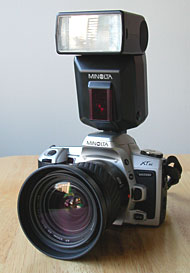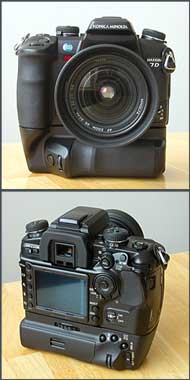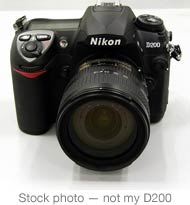
I currently shoot with a Nikon D200 digital SLR camera. This is after years of being a Minolta user with my first camera, a Minolta Maxxum XTsi and my first digital SLR, the Konica Minolta Maxxum 7D, both of which I thoroughly enjoyed.

The first camera I ever purchased was a Minolta Maxxum XTsi 35mm SLR camera back in 1998. I absolutely loved it! I chose Minolta primarily because the camera store sales rep recommended it, but it was also a much better looking camera than the comparably priced Canon EOS Rebel — it was suprisingly full-featured and well-built for an entry-level SLR. I still have the camera to this day, even though I don’t use it anymore. It was my first camera and I’ve grown somewhat fond of it, so for that reason, I don’t think I’ll ever get rid of it.
My interest in photography really started to kindle in 2004 when I had an opportunity to go to Italy. I realised that I knew very little about taking good photos and I didn’t want to come back from Italy with a bunch of boring photos. Unfortunately, the trip to Italy never happened (my charter flight got cancelled), but it awoke in me a desire to learn more about photography so I’d be ready the next time I went anywhere exotic.
At the end of 2004, I made a trip to Vancouver and decided to take some photos of one of Canada’s most picturesque cities. I shot four rolls of professional quality slide film and was suprised to have spent $100 in film and processing costs! I was painfully aware that if I wanted to practise my hand at photography, every press of the shutter release button would cost me another dollar, so I started to wonder if my time and money would be better spent on a digital camera.
Minolta didn’t have much in the digital SLR category, so I looked at what Canon and Nikon had to offer (see my Soapbox article on what to look for when buying a digital SLR camera). But then I learned of Minolta’s upcoming digital SLR — the Maxxum 7D — and I got very excited. I felt like it was exactly the camera I had been waiting for, so in January 2005, I purchased my very own Konica Minolta Maxxum 7D.

The Maxxum 7D was a wonderful camera. I chose it instead of the Nikon D70 or the Canon EOS 20D for a number of reasons. The most compelling was ergonomics: I liked the way Minolta designed cameras, whether it was my original XTsi, the DiMAGE A2 that I also considered, or the Maxxum 7D. Minolta cameras are thoughtfully filled with mechanical dials and controls, which feel more natural than the software-driven interfaces of other cameras. The large 2.5” LCD was another important usability factor, and the in-camera Anti-Shake feature also caught my interest.¹ I drew confidence from Minolta’s solid reputation for building high quality lenses, which have always been very good and were at least as good as Nikon or Canon lenses as far as my needs were concerned. Brand loyalty also played a small role in my decision, since I had been fond of my Minolta XTsi and the Maxxum 7D felt like a natural step forward.
In the end, I chose Minolta because I wanted to support their efforts in the digital SLR market. I felt that the Maxxum 7D represented a genuine — albeit expensive — alternative, and I was fairly confident that Minolta would be able to satisfy my current and future photography needs.
Well, Minolta pulled out of the Canadian market in Late 2005 and they completely pulled out of the global camera market in Early 2006. I wasn’t too bothered by this because by that time, I had accumulated all the equipment I thought I’d need for a while. My full complement of Minolta lenses and accessories consisted of the following items:
As much as I enjoyed the Maxxum 7D, I was also having some issues with it. The auto-focus system was somewhat slow, prone to hunting, and would sometimes pick the wrong focus targets (which is annoying when you don’t have lots of time to setup a shot, like when I was taking photos at my cousin’s wedding). I also noticed that the in-camera and post-processing software was not as sophisticated as what my brother’s Nikon D70 offered, so I could feel that my days as a Minolta user were numbered.
Don’t get me wrong — the Maxxum 7D was a great camera that delivered professional-level quality and usability. The auto-focus issue was very frustrating though, and I had other issues like the lack of availability of high-end lenses and accessories, the simplicity of in-camera software compared to Nikon, the lack of decent post-processing software, and the uncertainty that Sony (who had acquired Minolta’s assets) would be addressing these issues anytime soon. For most people, these would not be issues, but I have ambitions to learn all I can about photography and I felt like I was being held back. So with some reluctance, I purchased a Nikon D200 on July 1, 2006 and listed all my Minolta equipment on eBay — it was both a sad and joyous day at the same time.
1 While lens-based stabilisation systems from Canon and Nikon are also excellent solutions and may even perform better, having an image stabilisation feature built-in to the camera body reduces the cost and weight of lenses and offers image stabilisation with every lens you own, which is a compelling benefit.

My switch from the Minolta Maxxum 7D to the Nikon D200 only happened because the demand for Minolta equipment on eBay was unusually high and I knew I would get the most return from my heavy investment in Minolta gear. I spent a week preparing my auctions with sample travel pics and very alluring photos of the lenses and accessories I had for sale. I wanted my auctions to stand out, but I also wanted to give potential bidders confidence in the kind of fantastic results they could expect if they purchased my equipment.
I first thought I’d switch to the Nikon D70s because the Nikon D200 was more than twice as much money and I didn’t think I’d get enough from my auctions to pay for it. I stopped in at my local Henry's Camera store and tried the D70s before deciding to sell my stuff on eBay. I wasn’t particularly moved but I knew switching to Nikon was the right thing to do. Out of curiousity, I tried the Nikon D200 which they had on display and I immediately knew that the D200 was everything I wished the Maxxum 7D had been. I felt that if I were to give up my Maxxum 7D (a camera I really enjoyed using), I’d want its replacement to be equally compelling, so I decided to buy the D200 and hope that my auction proceeds would cover the cost. Fortunately, they did!
I have two lenses to go with my Nikon camera: the amasing AF-S DX VR Zoom-Nikkor 18-200mm f/3.5-5.6 IF-ED lens which my brother bought for me as a gift when we were in Hiroshima, Japan, and the very affordable and well performing AF Zoom-Nikkor 70-300mm f/4-5.6G lens which I bought specifically for taking photos at the 2006 Formula 1 Japanese Grand Prix. Even with just the 18-200mm lens, I can do more with my D200 than I ever could with the Minolta, and now I have a freakin’ Nikon D200! The coolness factor of that alone makes it worth the switch. I also have an SB-600 Speedlight so I don’t really need to buy anything else, but a nice portrait lens with better bokeh than my 18-200mm would be a welcome addition to my camera bag.